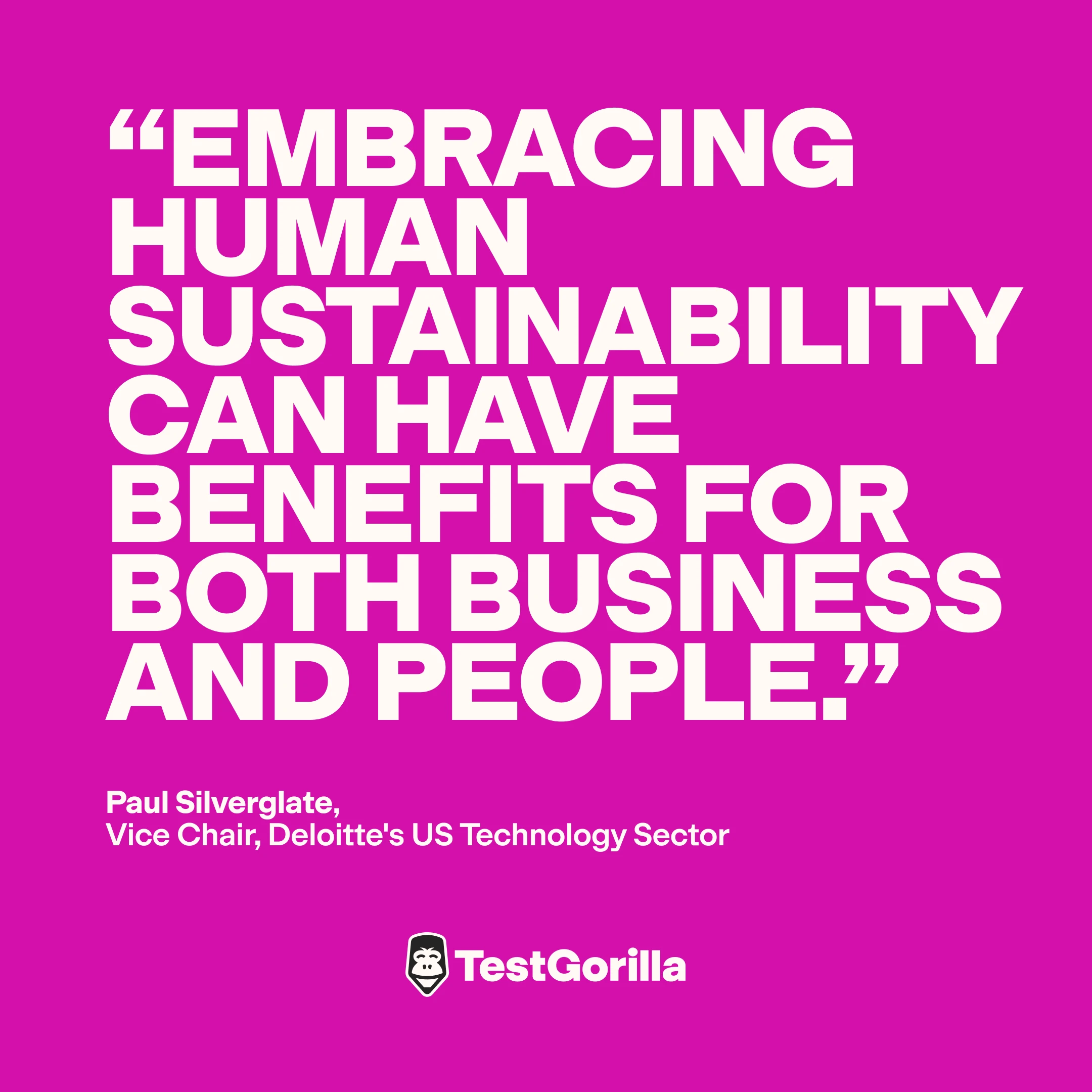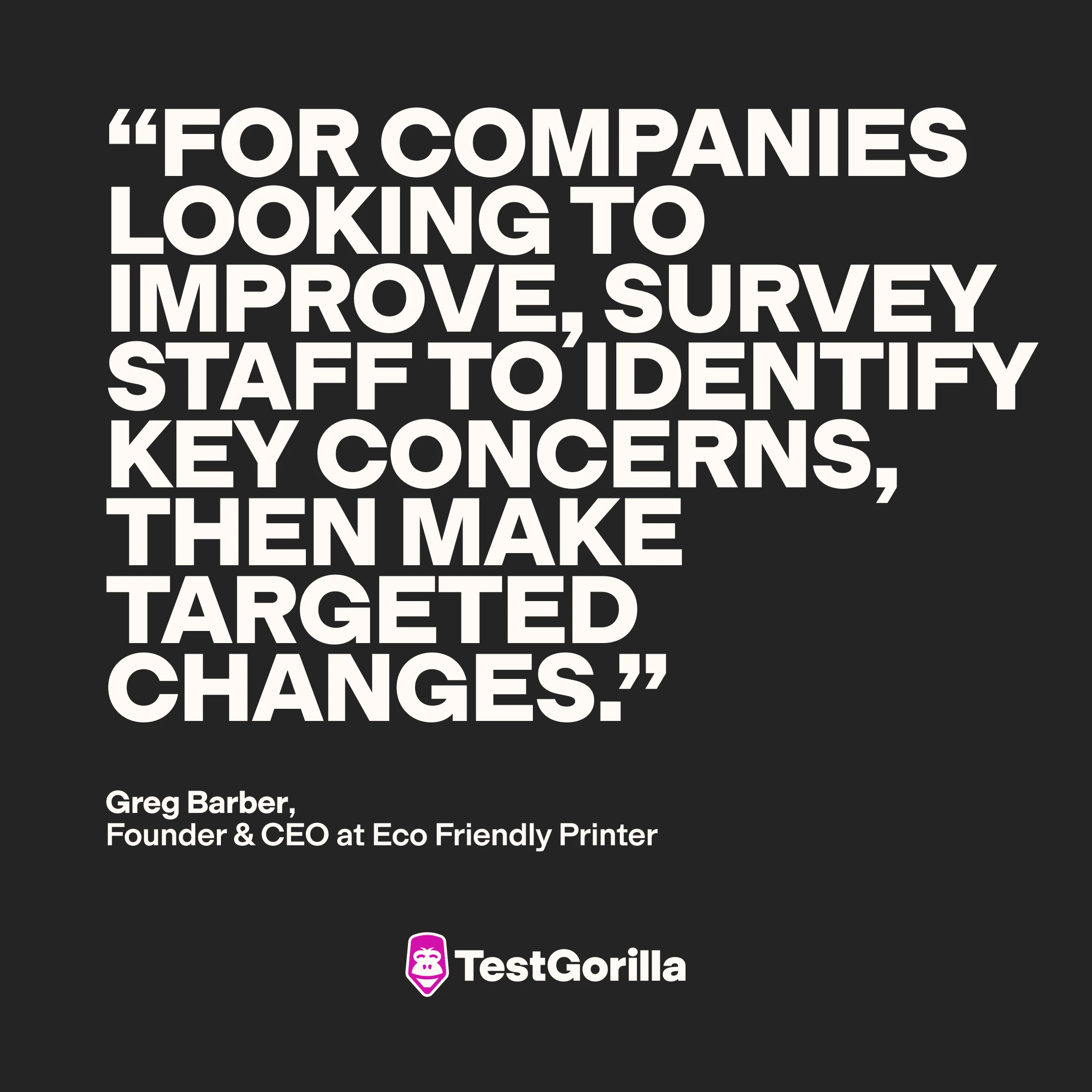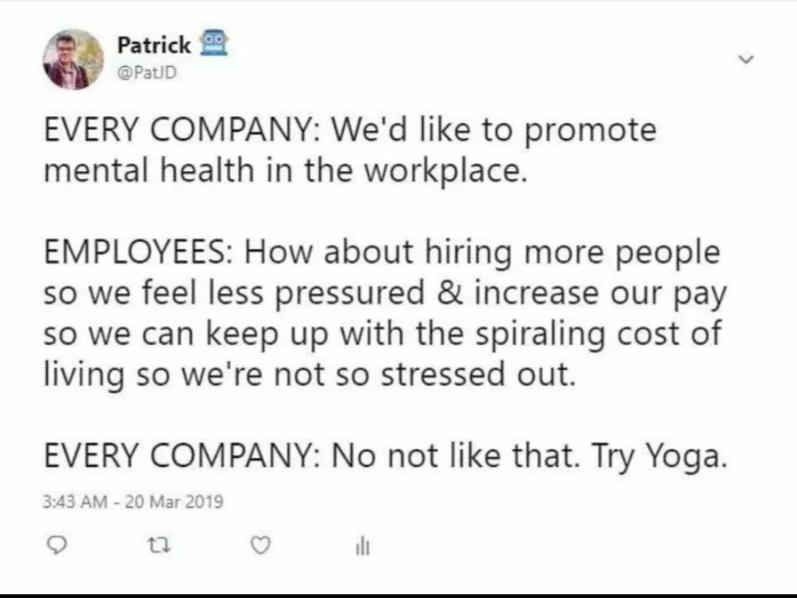Human sustainability isn’t a corporate buzzword. Here’s why you should care.
The modern workplace is facing serious and unprecedented challenges. Employees are burning out, struggling with economic uncertainty, and worried about losing their jobs to AI. This pressure can quickly spiral into high turnover, underperformance, and a web of other problems that impact your company's long-term success.
Many employers try to tackle these hurdles one at a time – offering a wellness program here, a training course there – but this piecemeal approach falls short and doesn’t solve the underlying issues.
The good news? You can address this with a single, powerful strategy: human sustainability.
In this article, we explain what human sustainability is, why it matters, and practical steps to implement it.
Table of contents
What is human sustainability?
Human sustainability is the practice of maintaining and enhancing the well-being, health, and quality of life of individuals and communities.
Just as we’ve come to realize that our planet needs careful nurturing, there's a growing awareness that people aren’t just resources to be used up – they need ongoing care and support to thrive.
Human sustainability’s focus on “human capital” (like well-being) sets it apart from other kinds of sustainability. For instance, environmental sustainability focuses on natural capital like land and water, while social sustainability focuses on social capital like shared values and resources.
What is the goal of human sustainability?
In the workplace, human sustainability aims to create an environment where individuals' basic needs are met, from fair employment opportunities and wages to job security and a safe, inclusive, and healthy environment. It also supports social connections, continuous learning, and personal growth, helping everyone flourish personally and professionally.
This mindset is crucial to the "social" aspect of ESG (environmental, social, and governance) – a broader framework that assesses a company's overall impact on the environment, society, and its governance practices.
Human sustainability ensures that businesses focus on more than just profits by considering the long-term well-being of their people.
HR expert Yashna Wahal explains this using a popular psychological framework. "Think of Maslow’s hierarchy of needs as a guide for setting human sustainability goals at work. At the base, you must meet people’s basic needs like fair pay and job security. As you move up, aim to create a safe and healthy work environment. At higher levels, foster a heightened connection to purpose through social initiatives, recognition, and growth opportunities."
Why you should care about human sustainability
Recent research by Deloitte showed that most C-suite members, including 80% of CEOs, felt pressured to make public commitments to improve human sustainability in their companies.
The surveyed C-suite members reported this pressure comes from every stakeholder group they work with, with 82% feeling it from employees, 78% from customers, 78% from investors, 77% from partners, and 77% from board members.
Ignoring this movement reduces your credibility with these stakeholders while making you miss out on the benefits human sustainability offers.
“Embracing human sustainability can have benefits for both business and people.” Paul Silverglate, Vice Chair, Deloitte's US Technology Sector
5 benefits of human sustainability at work
Here's how human sustainability can benefit your business.
1. Better business results and innovation
The Oxford Wellbeing Research Center found a strong positive relationship between employee well-being and organizational performance, including profits and stock returns.
Additionally, a study by IBM revealed that high-performing organizations – those that invest in employees' skills development – see better business results, including:
24% improvement in the ability to change procedures and products – a subset of innovation
14% increased productivity
22% faster delivery times
12% reduction in new hires' time to productivity
17% better customer satisfaction
Finally, a recent white paper by the World Economic Forum found that over 75% of consumers said they’re more likely to buy from companies that prioritize social responsibility. So, investing in human sustainability brings more customers through the door.
2. Higher employee engagement and retention
When employees are recognized and fairly paid for their contributions, they're more likely to feel motivated and engaged in the short term and stay with your company long-term. This can help you retain institutional knowledge and avoid high turnover costs.
This is what happened at PayPal. The company launched a financial wellness program that raised employees' disposable income by 26%, helped reduce their healthcare costs, and offered them stock awards regardless of tenure or seniority.
The result? Reducing workers' financial stress and making them feel valued led to all-time highs in employee engagement and productivity scores, retention rates, lower sickness and absenteeism, and even customer net promoter scores.
Deloitte also found that over 70% of employees believed they'd have a better work experience, higher engagement and job satisfaction, and a greater likelihood of staying with their companies if those companies committed to human sustainability.
3. Better diversity outcomes
Human sustainability efforts help create environments where everyone can thrive, regardless of their backgrounds, identities, or circumstances.
For example, according to the Chartered Institute of Personnel and Development (CIPD), offering fair employment opportunities, flexibility, and better work-life balance helps attract and retain underrepresented groups, including disabled workers or parents with caregiving responsibilities.
How does this help business? One report showed that companies with greater diversity perform 2.4 times better than their competitors.
4. Strong employer brand
Companies that practice human sustainability enhance their employer brand and reputation by promoting themselves as responsible employers and building a desirable workplace for current and future employees.
For instance, one study showed that job candidates look at companies’ "social" value – in addition to their market value – to assess whether they want to work there. The same study found that an employer's image also determines whether employees want to stay long-term.
5. Enhanced ESG impact
Companies that practice human sustainability often extend these values to broader ESG goals.
HR expert Yashna Wahal explains this from a corporate social responsibility (CSR) standpoint. "When you practice human sustainability, you're creating a culture of social responsibility, where you value your stakeholders for reasons beyond profitability. This, in turn, encourages them to engage in a wider range of sustainable practices, such as philanthropy, environmental initiatives, and more – prioritizing the greater good above their own needs."
How to practice human sustainability the right way
Human sustainability seems easy to implement, right? Offer flexible working, throw in some wellness programs, and roll out some training, right? Wrong.
According to Deloitte's research, 82% of company executives believe their organization is advancing human sustainability. However, just 56% of employees agree. Additionally, nine in ten executives think employees working for their companies experience improved well-being, career development, sense of purpose, and feelings of belonging – but fewer than six in ten workers agree.
There's a significant disconnect between what employers are doing and what employees are looking for. To see results, you must understand what people want and make robust changes.
Here are six ways to do this.
1. Find out what's important to people
Find out what stakeholders are looking for so you don't waste time on pointless initiatives.
You might read online research papers that measure what today's employees, investors, and customers seek.
For example, Deloitte recently surveyed nearly 23,000 millennial and Gen Z employees across 44 countries to track their work experiences. Findings revealed that these workers are grappling with anxiety around their finances, jobs, and the climate. The report also showed that they're looking for better work-life balance and a sense of purpose in their work.
Review your company's employee and customer satisfaction surveys, conduct focus groups, and speak to key stakeholders one-on-one for powerful insights into what you're doing well and where there's room for improvement.
"For companies looking to improve, survey staff to identify key concerns, then make targeted changes." Greg Barber, Founder & CEO at Eco Friendly Printer
2. Switch to skills-based hiring
A skills-based recruitment approach focuses on hiring people based on real-world skills rather than educational credentials or employment histories. This approach involves screening applicants using pre-employment tests and practical tasks instead of resumes, which are difficult to verify and can lead to unfair biases.
This approach gives everyone a fair opportunity to grab jobs, including those who were less privileged growing up, couldn't afford a college education, or didn't have strong connections with employers. It also lets you widen your talent pool and find STAR candidates – those skilled through alternative routes such as self-study or hands-on experience.
We recently surveyed over 2,000 employers and employees and found that nine in ten employers reduced mis-hiring, improved diversity, and increased retention with a skills-based approach.
Moreover, we found that over 82% of young employees preferred skills-based processes, and 90% of candidates believed it would help them secure their dream jobs. It's what they want and deem fair.
Finally, several companies have used skills-based assessments to identify internal mobility opportunities and upskill employees. For instance, Amazon’s Machine Learning University (MLU) puts tech employees through machine learning training to help them upskill – propelling their career growth and boosting job satisfaction and retention.
Switching to skills-based hiring improves business outcomes and showcases your commitment to fair hiring practices and continuous skills development – ultimately leading to equal employment opportunities, a core part of workplace human sustainability.
3. Put well-being under the microscope
Many employers view well-being as a one-size-fits-all concept. They'll implement blanket solutions like flexible working hours or wellness webinars, assuming these will address all employee needs.
However, well-being is multidimensional. It encompasses mental, physical, and emotional health, as well as work-life balance. Without addressing each of these and understanding each team member's unique needs, your efforts will fall flat.
"Health and wellbeing has to be done with people, not to them." Dr Shaun Davis, group director of safety, health and wellbeing at Belron International
Have regular one-on-ones or use polls and surveys to see how you can support employees' well-being. In some cases, broader approaches like flexible working, work-free weekends, or ergonomic desk setups can help employees across the board. In other cases, you should deal with concerns on a case-by-case basis.
For example, if someone's struggling with something in their personal life, you could offer them additional days off or subsidized therapy. If another employee has physical health problems, offer the support they need – anything from special parking privileges to dairy-free snacking alternatives. Even little things can go a long way.
4. Offer fair and competitive compensation
One survey showed that cost of living is a top concern for Gen Z and millennials today. More than half of both groups said they were living paycheck to paycheck. Research by MetLife, a big player in the financial sector, also outlined that 30% of workers admit to being less productive due to financial stress.
Consider these tactics to reduce employees' financial burdens and provide a sense of stability – both core to human sustainability.
Fair pay practices
Regularly audit employees' compensation structures and compare these to industry benchmarks to ensure they're fairly paid for their contributions. Additionally, highlight and address red flags, such as unwarranted pay gaps.
Pay transparency
Openly communicate how salaries, bonuses, and raises are determined and what your company's appraisal cycle looks like so employees aren't left in the dark. Refer to local laws and regulations, too – for instance, New York has mandated pay transparency in new job openings for NY state businesses with four or more employees.
That said, don't wait for the government to push this – do what you can to relieve employees of any guesswork.
Profit-sharing and ESOPs
In 2023, the National Center for Employee Ownership (NECO) found that employees who had employee stock ownership plans (ESOPs) experienced only a third of the national voluntary quit rates. These employees also had more than double the retirement savings compared to non-ESOP workers.
Introducing profit-sharing schemes where employees receive a share of the company's profits gives them a sense of a secure future and aligns their financial interests with the company’s success.
Employer-based savings program
To help employees feel financially safe, consider offering an employee savings program in which a portion of their paychecks goes into a separate savings account.
According to Commonwealth, a Boston-based financial security firm, 75% of employees would consider an employer-based savings program – and nearly all would participate – if employers matched their contributions. Furthermore, 62% felt it would make them work harder, 55% expected it to reduce absenteeism, and 76% said it could help retention.
Emergency financial assistance
Sometimes, employees face unexpected financial hardships that strain their well-being and impact their work performance. Create programs such as medical emergency or disaster-relief programs that could, for instance, offer interest-free loans to help employees recover from sudden tragedies.
5. Think about empowering, not just training
According to Devlin Peck, instructional designer and consultant, 85% of organizations with more than 50 employees offer formal training. Yet 43% feel their training is ineffective, and more than half of employees want more opportunities to develop their skills and improve their work.
That's why you should look beyond just offering standard training programs.
First, identify employees' specific skills gaps – for instance, through talent assessments.
Additionally, conduct one-on-one career development sessions with every employee at least twice a year to learn about their short-term career goals and long-term aspirations.
Then, offer the appropriate training and development opportunities, such as hard and soft skills training, professional development programs, and mentorship.
Finally, truly empower your employees so they have the autonomy and confidence to apply their new skills effectively. Do this through challenging projects, internal mobility opportunities, management responsibilities, and more.
"Standardisation devoid of empowerment can rob individuals of their dignity and prove counterproductive." Zeynep Ton, Professor of the Practice at MIT Sloan School of Management
One survey of nearly 24,000 respondents showed that offering employees the right resources, support, training, and opportunities led to psychological empowerment, which boosted job satisfaction, work engagement, and social well-being.
6. Foster a sense of purpose at work
A McKinsey report shared that the COVID-19 pandemic made about 70% of employees look for purpose in their work.
According to the report, when you help fuel employees' sense of purpose and meaning at work, they're healthier, more productive, more resilient, and more likely to stay with the company. The results are best when a company's overall mission aligns with the employee's values.
Try understanding what purpose means for them (for instance, through surveys or one-on-ones) and thinking about how you can help them achieve it at work. You might organize volunteer days, match their donations, encourage them to mentor junior coworkers, and more to help them find purpose and meaning in their daily jobs.
Human sustainability B&B: Barriers and best practices
Here are some common hurdles to adopting human sustainability and how to cross them.
Barriers | Best Practices |
Resistance to change Sometimes, a company's leadership or employees can resist new practices, especially if they're worried they’ll disrupt business. Additionally, according to Deloitte's 2024 Global Human Capital Trends report, some companies are stuck in a "legacy mindset," treating employees as resources to extract value from rather than partnering with them to create a better future for everyone. | ⭐Educate leadership on the value of human sustainability through hard data and case studies. ⭐Start with manageable efforts – such as switching to skills-based hiring and wellness initiatives that can show quick wins – before gradually scaling up. ⭐Engage employees at all levels in the planning and implementation stages to gain buy-in and reduce resistance. ⭐Tie managers and leaders' pay and promotions to human sustainability efforts. Deloitte showed that 88% of leaders embrace this, and 71% believe their company’s leadership should change if they aren’t thinking about human sustainability. |
Apprehension to set goals Nearly a third of leaders are apprehensive about making public human sustainability commitments because their realistic goals seem trivial and embarrassing. Further, 30% of employers are waiting for the government to offer human sustainability guidance, and 22% are worried they'll risk their company's reputation if they set goals and fail to achieve them. | ⭐Start with pilot programs that let you test and refine sustainability efforts before rolling them out on a larger scale and making public commitments. ⭐Clearly communicate the reasons behind chosen targets and how you plan to achieve them. This can help build a culture of trust and accountability. ⭐Create a contingency plan for responding to failed goals, adjusting targets, learning from setbacks, and communicating openly with stakeholders. |
Difficult to measure impact Unlike environmental metrics, such as carbon footprint, which are easier to quantify, human sustainability metrics are hard to define and measure. Only a fifth of leaders feel they have reliable metrics to measure it. | ⭐Use this reliable Human Sustainability Index (HSI). It looks at various aspects of human sustainability – from physical and mental health to social connections and financial stability. ⭐Run this or similar surveys at least annually to identify trends and areas for improvement. ⭐Track turnover rates, customer satisfaction scores, and other metrics that directly speak to how employees are feeling and performing in your company. |
Promote long-term human sustainability with skills-based hiring and more
Companies that get human sustainability right can stand out, attract and retain top talent, and achieve better business results.
To practice human sustainability, focus on skills-based hiring, personalized well-being initiatives, empowerment, fair pay, and purpose at work. Additionally, overcome barriers like resistance and measurement challenges by starting small, being transparent, and using tools like the HSI.
Remember, human sustainability isn't about lip service or quick fixes. It's about building a lasting culture where valuing people becomes second nature.
Related posts
You've scrolled this far
Why not try TestGorilla for free, and see what happens when you put skills first.
Latest posts
The best insights on HR and recruitment, delivered to your inbox.
Biweekly updates. No spam. Unsubscribe any time.

Skills tests to hire the best
Our screening tests identify the best candidates and make your hiring decisions faster, easier, and bias-free.
Free resources
A step-by-step blueprint that will help you maximize the benefits of skills-based hiring from faster time-to-hire to improved employee retention.
With our onboarding email templates, you'll reduce first-day jitters, boost confidence, and create a seamless experience for your new hires.
This handbook provides actionable insights, use cases, data, and tools to help you implement skills-based hiring for optimal success
A comprehensive guide packed with detailed strategies, timelines, and best practices — to help you build a seamless onboarding plan.
This in-depth guide includes tools, metrics, and a step-by-step plan for tracking and boosting your recruitment ROI.
Get all the essentials of HR in one place! This cheat sheet covers KPIs, roles, talent acquisition, compliance, performance management, and more to boost your HR expertise.
Onboarding employees can be a challenge. This checklist provides detailed best practices broken down by days, weeks, and months after joining.
Track all the critical calculations that contribute to your recruitment process and find out how to optimize them with this cheat sheet.


















